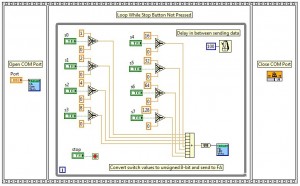MIAC with Arduino

The MIAC (Arduino compatible) is very different to the Raspberry Pi! All the circuitry is the same with the ATMEGA 1281 and a FDTI USB interface chip on the SODIMM card. To program the ATMEGA device you simply use the standard Arduino IDE. You will need to set the MIAC up as a valid hardware target – easy enough with the files supplied by the Dev guys.
As with the Pi, our development team have written a library of routines to allow you to easily interface with all parts of the MIAC’s hardware and comms interfaces using the Arduino language. Couldn’t be easier! If the Arduino C++ language is not to your taste then you can use Flowcode to program the Arduino MIAC. We like to think this is a whole lot easier than the Arduino C++ language and it has the advantage that you can simulate your MIAC and any electronic or electromechanical items in your system before downloading and testing in hardware. You can also use an AVR C compiler toolchain to develop code for the ATMEGA device.
The 16bit dsPIC MIAC uses a powerful 16 bit dsPIC33 device. It can be used with Microchip’s own MPLABX software IDE and C code. This too can use Flowcode and all hardware libraries are supplied.

Now, the AllCode is special. The purpose of AllCode technology is to allow engineers to make use of conventional PC-based programs like Visual Basic, LabVIEW, MATLAB, etc. The AllCode is a kind of dumb hardware box. We supply a DLL with a suite of libraries to control all the hardware and comms interfaces. This means that the AllCode always has to be connected to your PC, tablet or mobile phone when in operation – but it provides a nice, low cost interface for a whole variety of uses in the lab or the workshop. Maybe you can prototype using your favourite PC language and then deploy in your machines using one of the other MIAC’s?
The MI5466 is a fully specified industrial electronic controller, designed to operate with industrial control voltages. Housed in an attractive rugged, anthracite grey plastic moulding and with two physical mounting options, the MIAC is designed to give electronic engineers a rugged programmable controller based on a range of microcontroller variants. This MIAC is based on an AVR ATmega processor module and has the following features:
- Application development with Arduino IDE
- Application development and simulation with Flowcode v7 IDE
- 8 x 10 bit 0-12v analogue inputs
- 4 x relay outputs (8A 240V)
- 5 line by 20 character graphic display with backlight illumination
- 4 solid state high current drivers (5.6A total)
- Keypad (9 keys)
- Real Time Clock with super-capacitive backup
- Internal microSD card slot
- 9 to 24 VDC operating voltage
- Serial communications including RS232, RS485 and CAN
- Also available with Bluetooth or Wi-Fi communication modules (MI9335)
See our MIAC with Arduino getting stated guide here! To view a datasheet with all the technical data on all of our MIAC available, click here!
How much does it cost?
MI5466 – MIAC ARDUINO COMPATIBLE – £199.00 + VAT
MI9335- MIAC ARDUINO COMPATIBLE WITH WI-FI – £229.00 + VAT
2,965 total views, 1 views today


